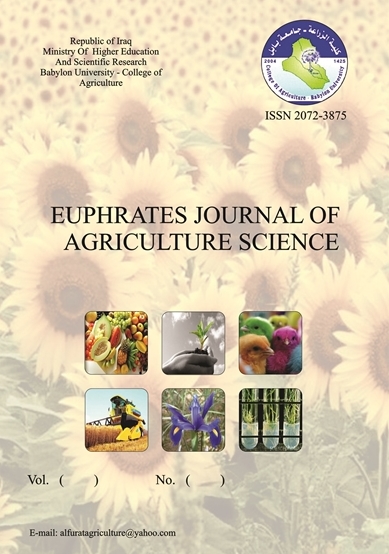Abstract
A comprehensive survey for the natural enemies of aphid species infesting different plant host was carried out during the period from 1.10.2009 – 30.9.2010 in Babylon governorate .
The results reveald that there are four predatory Coccinellids namely : Coccinella septempunctata , C.transversogotata L. , C. undecimpuncatata L. and Pharoscymnus setulosus ( Coleoptrea : Coccinellidae ) that prey on different aphid species . Another predators on aphids were recorded during this study , these consist of Chrysopa carnea and Chrysopa sp. , (Neuroptera : Chrysopidae) and Syrphus balteatus ( Diptera : Syriphidae )
Two parastic Hymenopteran insects were also recorded during this research , Aphidus sp. and Aphelinus sp. (Braconidae ) . The result , showed that some aphid species were found to be infected with an entomopathogenic fungi Beauveria bassiana
The seasonal abundance of all natural enemies recorded in the present study was recorded . too .
More than 16 aphid species were indentified during this study :
1. Aphis fabae Scopoli 1763 .2. A. punica ( Passrini )
3. A. gossypii Glover 1877 4. A. nerii Boyer de Fonscolombe 1841
5. A. pomi De Geer 6. A. craccivora Koch 1854
7. Therioaphis trifollii ( Monell ) ( T. maculate Buck. )
8. Rhopalosiphum maids ( Fitch ) 9. Schizaphus ( Toxoptera ) graminum ( Rond. ) 10. Brevicoryne brassicae ( L. , 1758 )
11. Myzus persicae ( Sulzer ) 12. Brachycaudus amygdalinus ( Schout )
13. Macrosiphum sanborni ( Gillelle ) 14. Macrosiphum rosae ( L. , 1758)
15. Acyrthosiphon pisum ( Harris ) ( = Macrosiphum si pi ) and 16. Uroleucon chi son ( L. , 1767 )
The seasonal abundance and host_plants of these aphid species were recoded , too .
The results reveald that there are four predatory Coccinellids namely : Coccinella septempunctata , C.transversogotata L. , C. undecimpuncatata L. and Pharoscymnus setulosus ( Coleoptrea : Coccinellidae ) that prey on different aphid species . Another predators on aphids were recorded during this study , these consist of Chrysopa carnea and Chrysopa sp. , (Neuroptera : Chrysopidae) and Syrphus balteatus ( Diptera : Syriphidae )
Two parastic Hymenopteran insects were also recorded during this research , Aphidus sp. and Aphelinus sp. (Braconidae ) . The result , showed that some aphid species were found to be infected with an entomopathogenic fungi Beauveria bassiana
The seasonal abundance of all natural enemies recorded in the present study was recorded . too .
More than 16 aphid species were indentified during this study :
1. Aphis fabae Scopoli 1763 .2. A. punica ( Passrini )
3. A. gossypii Glover 1877 4. A. nerii Boyer de Fonscolombe 1841
5. A. pomi De Geer 6. A. craccivora Koch 1854
7. Therioaphis trifollii ( Monell ) ( T. maculate Buck. )
8. Rhopalosiphum maids ( Fitch ) 9. Schizaphus ( Toxoptera ) graminum ( Rond. ) 10. Brevicoryne brassicae ( L. , 1758 )
11. Myzus persicae ( Sulzer ) 12. Brachycaudus amygdalinus ( Schout )
13. Macrosiphum sanborni ( Gillelle ) 14. Macrosiphum rosae ( L. , 1758)
15. Acyrthosiphon pisum ( Harris ) ( = Macrosiphum si pi ) and 16. Uroleucon chi son ( L. , 1767 )
The seasonal abundance and host_plants of these aphid species were recoded , too .
